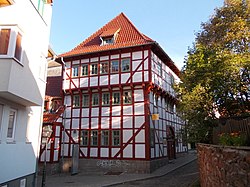Finkenburg (Nordhausen)
| Finkenburg | ||
|---|---|---|
 Finkenburg (2013) |
||
| Data | ||
| place | Nordhausen am Harz | |
| Architectural style | Gothic half-timbered house | |
| Construction year | around 1444 | |
| Coordinates | 51 ° 30 '11.6 " N , 10 ° 47' 25.7" E | |
|
|
||
The Finkenburg is a Gothic half-timbered house in Nordhausen am Harz and is a landmark of the city.
Surname
The name was originally Finklerburg and probably goes back to Heinrich I , who was also known as Heinrich the Finkler , who had a castle built on this site around 910. The castle complex was burned by Heinrich the Lion in 1180 , then rebuilt and finally destroyed by the citizens in 1277.
history
Today's Finkenburg was built around 1444 as a frame structure with a cantilevered upper floor on a cellar that dates back to the 14th century. With its two-storey continuous studs , the strictly implemented framework system and the connection with the attached upper storey, which protrudes over Knaggen , the Finkenburg is a mixture of multi-storey buildings and individually timbered storeys typical of the mid-15th century. Due to the numerous alterations and changes, an exact description of the structural condition of the half-timbered house at that time is no longer possible, but it should roughly correspond to today's appearance.
The exact use before 1860 is unclear, since then the Finkenburg has been used as a residential building. The structural condition deteriorated visibly at the beginning of the 20th century due to too many residents and poor hygiene. In 1915 part of the beams inside was broken, the stairs rotten and the windows broken; living was hardly possible any more, but 39 people lived in the house at that time.
The city refused to demolish it by the owner Otto Kellermann in 1921. Two years later, the German-American Ulrich König from Milwaukee bought the building and gave the Finkenburg to his hometown Nordhausen as a gift.
The reconstruction in April 1927 could only be realized through great efforts of the citizens of Nordhausen and private donations. Since the renovation, the main building in the area of the stud house has only two floors. The second floor protrudes above it as a floor. The interior of the house was designed in a contemporary style.
The Finkenburg was used as a guild house until 1940, after which parts of the building housed a day-care center for 100 children. After 1945 the Finkenburg was the party house of the SED , in 1959 it was used again as a house for the craftsmen.
In 1993 the inside of the building was badly damaged by arson. After a restoration true to the original, the Finkenburg was able to reopen in 1997.
literature
- Susanne Hinsching: The Finkenburg in Nordhausen. In: Yearbook of the district of Nordhausen (1994). Neukirchner, Nordhausen 1995, pp. 32-36.
- Susanne Hinsching: The Finkenburg in constant interest. In: Yearbook of the district of Nordhausen (1996). Neukirchner, Nordhausen 1997, pp. 9-10.
Web links
- Finkenburg at NordhausenWiki
Individual evidence
- ↑ Susanne Hinsching: The Finkenburg in constant interest . In: Yearbook of the district of Nordhausen (1996) . Nordhausen: Neukirchner, 1997. p. 9.
- ↑ Susanne Hinsching: The Finkenburg in constant interest . In: Yearbook of the district of Nordhausen (1994) . Nordhausen: Neukirchner, 1996. p. 33.
- ↑ Susanne Hinsching: The Finkenburg in constant interest . In: Yearbook of the district of Nordhausen (1994) . Nordhausen: Neukirchner, 1996. p. 34.



